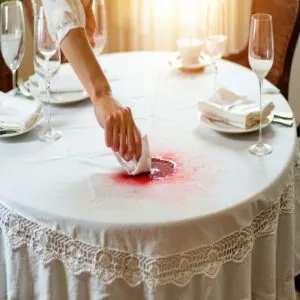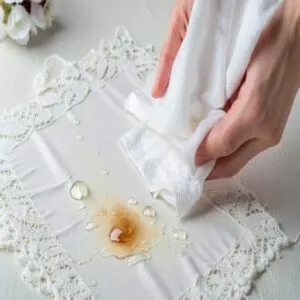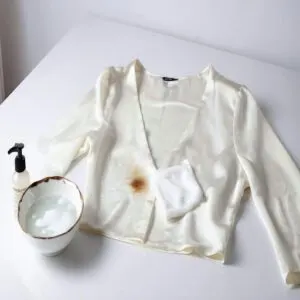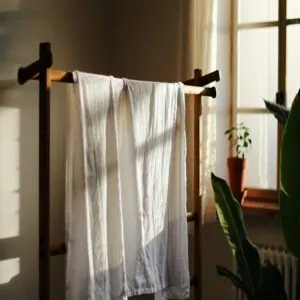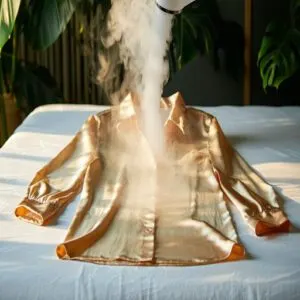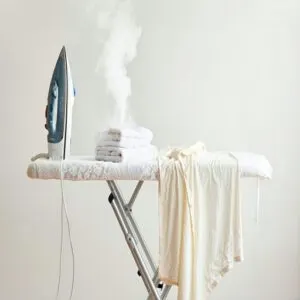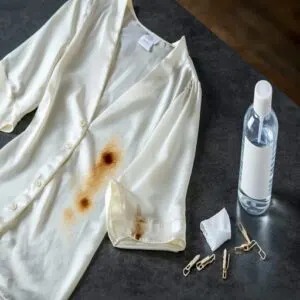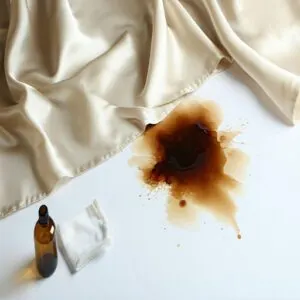This site is supported by our readers. We may earn a commission, at no cost to you, if you purchase through links.
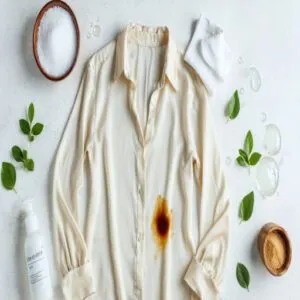 Removing stains from delicate fabrics doesn’t have to be a nightmare.
Removing stains from delicate fabrics doesn’t have to be a nightmare.
First, identify your fabric and stain type—silk’s not the same as wool, and oil stains play by different rules than coffee spills.
Act fast with cold water to stop stains from settling.
Blot, don’t scrub, with a clean white cloth.
Use gentle, safe solutions like vinegar, baking soda paste, or mild detergent.
Always test in an unseen spot first—better safe than sorry!
Got an oily spill?
A dab of dish soap works wonders.
Protein stains like blood?
Stick to cold water and enzyme-free soaps.
Remember, patience saves fabrics… and your sanity!
Table Of Contents
- Key Takeaways
- Delicate Fabric Stain Removal
- Gentle Cleaning Solutions
- Removing Oily Stains
- Protein-Based Stain Removal
- Tannin Stain Removal
- Drying and Pressing Delicates
- Specialized Stain Removal
- Preventing Future Stains
- Removing Tough Stains
- Professional Cleaning Services
- Frequently Asked Questions (FAQs)
- Conclusion
Key Takeaways
- Act fast when dealing with stains—blot gently with a clean white cloth and use cold water to stop them from setting.
- Identify your fabric and stain type before treating it; silk needs different care than wool, and oil stains require different methods from protein stains.
- Use gentle solutions like vinegar, baking soda paste, or enzyme-free detergents, and always test on an inconspicuous area first.
- For tough or persistent stains, avoid aggressive scrubbing and consider professional cleaning to prevent damage to delicate fabrics.
Delicate Fabric Stain Removal
Removing stains from delicate fabrics doesn’t have to be a challenging task if you know what to look for.
By understanding your fabric type and the nature of the stain, you can tackle each spot with confidence and care.
Identifying Fabric Type
Figuring out your fabric type is step one to stain removal success.
Silk care differs from wool, so fabric identification is key.
Here’s how:
- Check the label for the material (easy win!).
- Feel the texture—smooth silk vs. fuzzy wool.
- Test the stretch; delicate fabrics rarely stretch.
- Learn fiber identification with burn tests (carefully!).
Nail this, and you’re halfway there!
Common Stain Types
Understanding common stains is like reading clues on a mystery fabric.
Ink stains stand out boldly, while grease stains leave a slick trail.
Food stains? They’re tricky chameleons.
Quick stain identification protects against fabric damage and potential color bleeding.
Always perform fabric testing before tackling stains.
This guarantees safe stain removal from delicate fabrics, keeping them pristine and ready for anything.
Pre-Treatment Methods
Before removing tough stains, stain pretreatment is your secret weapon.
Always test a mild solution on an inconspicuous spot first. Cold water is your best friend for fresh spills. Use gentle blotting instead of scrubbing—think pat, don’t attack.
When working with delicate fabrics, understanding delicate fabric care is essential for successful stain removal and overall fabric preservation.
- Blot softly with a white cloth.
- Spot-test any cleaner.
- Apply cold water immediately.
- Use mild solutions for delicate fabric care.
- Avoid rubbing aggressively to prevent damage.
Gentle Cleaning Solutions
You don’t need harsh chemicals to tackle stains on delicate fabrics—gentle solutions can work wonders.
From natural ingredients like baking soda to enzyme-free detergents, these options clean effectively without harming your favorite pieces.
Natural Cleaning Agents
Natural cleaning agents like vinegar solutions and baking soda aren’t just pantry staples—they’re lifesavers for delicate fabric care.
A mix of vinegar and water helps break down stains, while a baking soda paste tackles tougher spots.
Pair those with gentle soaps or eco cleaners, and you’ve got reliable, effective options.
Always stick to gentle cleaning methods to protect fragile fibers.
Enzyme-Free Detergents
In the area of fabric safety and delicate fabric care, enzyme-free detergents are your best bet.
These gentle cleansers protect fibers like silk during mild washing and fabric stain removal. Ideal for silk care and delicate wash cycles, they clean effectively without harsh reactions.
Using enzyme free detergent alternatives can also be beneficial for sensitive skin.
Stick to gentle detergents for stress-free cleaning and preserve your fabrics’ elegance with these trusted solutions.
Eco-Friendly Options
Sometimes, your delicate fabrics just need a little love with green cleaning.
Swap harsh chemicals for gentle detergents like plant-based eco detergents or biodegradable agents.
Natural cleaning agents—think vinegar or baking soda—work wonders without harming sustainable textiles.
For more information on eco friendly methods, exploring alternative approaches can be beneficial.
For stubborn spots, DIY solutions like cornstarch or lemon juice deliver big results while staying eco-friendly.
Care for delicates doesn’t have to cost the planet.
Removing Oily Stains
Oily stains on delicate fabrics can feel like a lost cause, but they’re easier to tackle than you think.
With the right blotting techniques and a bit of dish soap magic, you can gently lift the grease without harming the fabric.
Blotting Techniques
Let’s talk blotting: the unsung hero of stain removal techniques for delicate fabrics.
Forget scrubbing—think gentle cleaning! Use a soft, white cloth and apply light pressure to blot stains without spreading them. For effective stain blotting methods, it’s vital to have the right tools.
- Gently press to absorb with a clean cloth.
- Spot clean using cold water for fresh oily spots.
- Repeat delicate wiping until the stain fades, which is a key part of stain removal and requires gentle cleaning techniques.
Mild Detergent Solutions
After blotting, it’s time to reach for mild detergent solutions.
Choose gentle cleaners or eco detergents designed for delicate fabrics. Mix a small amount with cool water, and gently blot or soak the fabric according to care instructions.
For the best results, using a mild detergent is essential to preserve the quality of delicate fabrics.
Avoid scrubbing—stick to mild washes to protect fibers. Soap alternatives like fabric softeners won’t clean stains but can preserve softness.
Dish Soap Applications
Dish soap is a simple yet powerful stain lifter for oily messes on delicate fabrics.
Follow these steps:
- Mix a few drops of soap concentrate with cool water.
- Spot-test for fabric safeguards.
- Dab gently with a white cloth—don’t rub!
- Rinse with cold water to prevent residue.
- Air dry to avoid heat damage.
Safe and effective!
Protein-Based Stain Removal
Protein stains like blood or chocolate can be tricky, but they’re no match for the right techniques.
Acting fast with cold water and gentle cleaners will save your fabric from permanent damage.
Blood Stain Removal
Blood stains on delicate fabrics need quick action.
Use cold water treatment immediately—warm water sets stains!
Blot with a damp cloth for gentle stain lifting, avoiding rubbing.
Try a fabric enzyme solution for stubborn spots, but always test first.
| Mistake | Outcome | Fixing It | Why It Works |
|---|---|---|---|
| Using hot water | Stain sets permanently | Stick to cold water | Stops protein bonding |
| Aggressive scrubbing | Tears or damages fabric | Blot gently with a cloth | Preserves delicate fibers |
| Ignoring testing | Ruined colors or texture | Spot-test on hidden areas | Keeps fabric safe from damage |
| Waiting too long | Stain becomes permanent | Act immediately | Prevents deeper absorption |
Keep silk stain removal sweet by blotting fast, and trust these stain removal techniques!
Chocolate Stain Treatment
That delicate fabrics isn’t a death sentence for your favorite silk blouse when you encounter a chocolate smudge.
The first step in removal is to flip the garment inside out and directing cold water through the back of the stain to push chocolate outward.
For gentle cocoa removal, blot—don’t rub—with a clean cloth, targeting both sugar stains and milk fat components.
To learn more about chocolate stain removal techniques, consider consulting a professional for delicate items, and Follow fabric care instructions carefully, treating the chocolate stain immediately for best results.
Enzyme-Based Cleaners
When chocolate stains prove stubborn, eco-friendly enzyme cleaners offer a smart solution.
These gentle formulas use specialized proteins that break down bio-based stains at the molecular level.
For delicate fabrics, look for enzyme products containing proteases, which target protein-based marks while being kind to your garments.
You’ll need patience though – these stain removal techniques work slower than harsh chemicals, but they’re worth the wait for an eco-friendly solution.
Tannin Stain Removal
Tannin stains like coffee, tea, and wine can cling stubbornly to delicate fabrics, but they’re not impossible to remove.
With the right steps and a bit of patience, you’ll protect your fabric while tackling the stain effectively.
Coffee and Tea Stains
Coffee or tea spills on delicates? Don’t panic. Tannin stains can leave behind frustrating discoloration, but gentle cleaning works wonders.
- Quickly blot – use a clean cloth for Tea Blotting or Coffee Removal.
- Dilute the stain – dab with cold water to loosen tannins.
- Try mild solutions – mix vinegar or baking soda.
- Avoid scrubbing – gentle dabbing is key!
Wine Stain Removal
Red wine stains can feel like a disaster, especially on delicate fabrics.
Act fast—grab a clean cloth to blot, then sprinkle salt or baking soda to absorb extra liquid.
A mix of cool water and mild detergent works wonders.
Here’s a quick wine stain removal guide:
| Step | What to Use | Why It Works | Important Tip |
|---|---|---|---|
| Blotting | Clean cloth | Absorbs excess wine | Don’t rub—blot gently |
| Absorbing | Salt/Baking Soda | Draws out liquid | Apply generously |
| Soaking | Cold water | Prevents stain setting | Avoid hot water |
| Washing | Mild detergent | Gentle stain removal | Spot-test fabric first |
This guide provides a quick wine stain removal process that is easy to follow and can help remove stains effectively, always remember to act fast and use the right techniques to prevent the stain from setting.
Fruit Stain Treatment
Fruit stains on delicate fabrics might seem like a nightmare, but don’t panic.
For berry stain removal or tackling tropical fruit stains, flush with cold water first—never hot.
Dab lemon juice or vinegar for acidic stain treatment, then rinse.
Use gentle cleaning agents like enzyme-free detergents.
Avoid rough handling, and handwash delicate fabrics.
Quick action is your best fruit juice cleanup strategy!
Drying and Pressing Delicates
Drying and pressing delicate fabrics takes patience and the right techniques to avoid damage.
From air drying to careful steaming, you’ll keep your delicates looking their best with just a little extra care.
Air Drying Methods
For air drying delicate fabrics, patience is your best friend.
After gently squeezing out excess water, use a drying rack to keep airflow steady and prevent mildew.
Lay items flat to maintain their shape, and avoid sunlight to protect colors.
Reshape garments as needed so they dry beautifully.
- Gently squeeze, don’t wring.
- Lay flat on a drying rack.
- Avoid direct sunlight.
- Make sure there’s proper air circulation.
Steaming Techniques
Steaming techniques work wonders for delicate fabrics—it’s like a spa day for your clothes.
Hold a handheld steamer a few inches away to prevent water spots and press steadily for gentle cleaning.
Steam cleaning refreshes the fabric and loosens lingering marks without harsh contact.
Keep it light and controlled—overdoing it might leave your delicates crinkled, not crisp!
Ironing Precautions
In the case of delicate fabrics, ironing methods matter.
Use a low setting and place a pressing cloth between the iron and fabric to avoid fabric scorching.
For tricky lace or embellishments, skip direct heat and stick to Steam Iron Tips instead.
Double-check the garment label for Iron Temperature guidelines—gentle cleaning doesn’t end with washing!
Specialized Stain Removal
In the case of tricky stains on delicate fabrics like silk, cashmere, or lace, you’ll need the right tools and techniques to avoid damage.
Treat each fabric with care, following methods customized to its unique needs for the best results, especially for delicate fabrics and using the right techniques.
Silk Stain Removal
Silk stain removal doesn’t have to feel like threading a needle.
For oily spots, sprinkle talcum powder or cornstarch to soak up grease. Dab stubborn stains with a vinegar-water mix, but spot-test first.
Skip scrubbing—it’ll ruin the fabric. Use gentle cleaning solutions to protect color and avoid fabric damage.
Persistent stains? Take silk care seriously and consult a pro!
Cashmere Stain Treatment
Stains on cashmere can feel like a disaster, but they’re fixable.
Act quickly and use gentle cleaning to avoid damaging those soft fibers.
Try these tips:
- Dab, don’t rub, with a clean cloth to absorb spills.
- Use enzyme-free detergents for cashmere care and stain removal.
- Air dry flat to prevent stretching and maintain fiber restoration.
Lace Stain Removal
When tackling lace stain removal, treat it like a fine art.
Start with fabric testing in a hidden spot to avoid disasters. Use gentle blotting—never rub—and mild agents like vinegar or enzyme-free detergent.
For ink spots, a little stain mapping goes a long way. Delicate rinsing in cold water seals the deal for safe, effective lace care.
Preventing Future Stains
You can keep stains at bay by taking a few simple precautions to protect your delicate fabrics.
From using fabric protector sprays to storing items properly, these steps make a big difference in preventing future mishaps.
Fabric Protector Sprays
A fabric protector spray is your secret weapon for keeping delicate fabrics safe from spills and stains.
It adds a protective coating while maintaining gentle finishes.
Understanding garment protection methods is essential for extending the life of your garments.
- Start clean: Always pretreat stains before using.
- Spray evenly: Cover fabric with a light, even mist.
- Reapply regularly: High-traffic items need frequent refreshes.
It’s a must-have for stain repellent success and keeping your garments safe with fabric protector and understanding garment protection methods.
Storage Methods
Keep delicate fabrics fresh by using breathable garment bags or storage bags for protection.
Fold items neatly to maximize closet organization and extend their shelf life.
Opt for breathable containers to prevent mildew, and avoid sealing fabrics in plastic.
Use padded hangers for hanging pieces, and always store in a cool, dry spot away from sunlight to preserve quality.
Pre-Treatment Tips
Start strong with solid pretreatment steps to save your delicate fabrics.
Assess stains carefully—ink stains? They need cold water fast! Always test cleaning solutions on a hidden spot. Pretreating stains the gentle way is key.
- Gentle Blotting: Dab, don’t rub, to avoid fabric damage.
- Spot Cleaning: Use mild cleaners sparingly on stains.
- Fabric Testing: Avoid surprises—always test first!
Removing Tough Stains
Tough stains can feel impossible to tackle, but you can conquer them with the right approach.
From grease to nail polish, a little patience and the proper methods can save your delicate fabrics.
Grass Stain Removal
Those pesky green stains from your latest picnic adventure?
Grass stains are no joke, especially on delicate fabrics.
First, rinse with cold water to stop the stain from setting.
Dab on a gentle laundry detergent or vinegar solution—no scrubbing!
For tougher outdoor stain solutions, try spot-treating with a mild soap.
Grass stain causes don’t have to ruin a favorite piece, especially with the right laundry detergent or a vinegar solution.
Grease and Oil Stains
Stubborn grass marks handled? Now, let’s tackle grease stains.
Oily stains on delicate fabrics can feel like a battle, but here’s your game plan.
- Blot the spot gently with a clean cloth—avoid smearing!
- Sprinkle cornstarch or baking soda to absorb excess oil.
- Use a mild fabric degreaser for targeted cleaning.
- Handwash with cool water, protecting fibers, and remember delicate fabrics.
Nail Polish Stain Removal
Nail polish stains on delicate fabrics can feel like a disaster, but don’t worry—it’s fixable!
Remove excess polish carefully, then treat the stain with soap.
If needed, try nail polish remover (skip this on acetate fabrics).
Always test first!
| Fabric | Test Area | Cleaning Tip |
|---|---|---|
| Silk | Inside seam | Avoid excess moisture |
| Cashmere | Hidden edge | Soap with gentle strokes |
| Lace | Small corner | Dab, don’t scrub |
When dealing with different fabrics, it’s essential to follow specific cleaning tips to avoid further damage, making nail polish remover a crucial tool in some cases.
Professional Cleaning Services
Sometimes, a tricky stain or fragile fabric is best left to the professionals. They’ve the tools and expertise to restore delicate pieces without risking further damage.
When to Seek Expert Help
Sometimes, stains or fabric damage call for expert help. Here’s when to seek professional guidance:
- The stain resists removal after multiple tries.
- Delicate fabrics appear weakened or discolored.
- It’s an emergency cleaning for a cherished item.
- Specialized stains (like ink) require expert stain removal.
- Restoration services are essential for aged or vintage fabrics.
Let experts handle delicate fabric washing confidently.
Restoring Damaged Fabrics
When stains push delicate fabrics to their breaking point, it’s time to think about fabric repair and textile restoration.
Experts use fiber fixing methods suited to your garment’s needs, whether it’s silk with water damage or lace with discoloration.
Avoid DIY damage control; instead, let skilled hands bring life back to your treasured pieces, which can benefit from fabric revival that works wonders!
Preserving Delicate Items
Preserving delicate fabrics starts with smart storage and handling.
Use these tips to keep your treasures intact:
To maintain the quality of delicate items, understanding delicate fabric care is essential for their longevity.
- Fabric Storage Tips: Store items in breathable fabric bags or acid-free tissue paper.
- Delicate Care Products: Choose gentle solutions like enzyme-free detergents.
- Gentle Folding Techniques: Fold along seams to minimize creasing.
- Item Handling Precautions: Avoid overhandling or tugging on fragile fabrics.
Frequently Asked Questions (FAQs)
How do you remove stains from fabric?
Blot stains gently with a white cloth, avoiding rough scrubbing.
Use cold water or a mild detergent for most stains.
Always spot-test methods beforehand, and for tough stains, consider baking soda paste, vinegar, or professional help.
How do you remove cotton stains?
An ounce of prevention is worth a pound of cure.
For cotton stains, dab with cold water, apply diluted detergent or vinegar, and launder immediately.
Avoid heat—it locks stains in.
Test solutions on hidden spots first.
Can fabric stains be removed?
Stains can absolutely be removed, but it takes the right approach.
Act quickly, identify the stain type, and use gentler techniques for delicate fabrics.
Treating stains carefully can save your fabrics from lasting damage!
How do you remove stains from outdoor furniture?
Tackle outdoor furniture stains by mixing warm water, mild soap, and white vinegar.
Scrub gently with a soft brush, rinse, and air dry.
For tougher stains, a baking soda paste or pressure washer works wonders.
Can you wash fabric stains?
You can absolutely wash fabric stains, but it depends on the fabric type and stain.
Test first, use cold water to avoid setting stains, and go for gentle detergents—don’t rush, and skip aggressive scrubbing!
How do you remove juice stains from clothes?
When life hands you lemon juice stains, act quick!
Blot the spot with a white cloth, rinse in cold water, and use a mild detergent.
Avoid hot water—it’ll set the stain faster than you blink.
How do you get tough stains out of delicate clothes?
Tough stains on delicate clothes need finesse—spot-test a gentle solution, like white vinegar or baby shampoo, on a hidden area.
Blot, don’t rub, and rinse with cold water.
Persistent stains? Try professional help to save your garment.
How to remove old stains from delicate fabric?
Old stains can be tricky, but start with a gentle soak in cold water mixed with mild detergent or vinegar.
Patience is key—don’t scrub!
If it’s stubborn, consider spot-testing a delicate stain remover.
Why should you not try to remove stains on delicate fabrics?
Trying to remove stains on delicate fabrics without proper knowledge can backfire.
You risk damaging fibers, fading colors, or setting the stain permanently.
It’s like pouring gas on a fire—care and expertise are a must!
How can you treat stains when hand washing delicate fabrics?
Ever panicked over a spill on your favorite silk?
Don’t rub it—blot gently with a white cloth.
Mix cool water with mild detergent, spot-test first, and hand wash carefully, avoiding excessive wringing.
Conclusion
An ounce of prevention is worth a pound of cure, especially in the case of delicate fabrics.
By knowing your fabric, acting fast, and using the right techniques, you’ll save time and frustration.
Whether it’s blotting oily stains with dish soap or treating protein stains with cold water, each step matters.
Removing stains from delicate fabrics doesn’t have to be stressful, with these tips, you’ll keep your favorite pieces looking flawless and good as new.
- https://deepcleaning.ie/article/stain-removal-tips/how-to-remove-stains-on-delicate-and-specialty-fabrics
- https://knowingfabric.com/how-to-remove-stains-from-delicate-fabrics/
- https://www.tradeuno.com/blogs/news/how-to-remove-stains-from-different-fabric-types
- https://www.thelaundress.com/blogs/tips/how-to-stain-guide-delicate-stain-guide
- https://prohousekeepers.com/blog/learn-all-there-is-to-know-about-stain-removal-on-clothes-fabrics/



